2. Noticing – Looking carefully
Noticing involves being ready, willing, and able to: be attentive to details and subtleties in seeking to understand things; seek underlying patterns patiently, understanding that connections may take time to emerge; actively use all the senses to gather information to build understanding of the world around; gain a clear sense of the ‘what’ of something before considering the ‘why’ and ‘how’; recognise that learning is often complex and difficult and takes time and effort to accomplish. So students need to learn how to focus their attention; to look patiently beyond the obvious to see detail and subtlety; to be able to identify the relative importance of what they are observing; to develop the ability to see detail in the context of the bigger picture; and to develop the ability to explain, hypothesise about and explore what is being noticed. When looked at from these diverse angles, growing noticing moves well beyond encouraging a student to ‘look carefully’.
How well does your classroom climate encourage Noticing? ⬇️
Does my classroom climate encourage Noticing?
Here is a selection of features that might begin to shape the emotional climate of your classroom to encourage noticing.
The diagram has 4 sections:
- Top – strategies you could build into the way you teach to stimulate noticing;
- Right – indications of the sort of language you might use to stimulate noticing;
- Bottom – ways in which you might celebrate / praise students’ use of noticing;
- Left – things that you need to enable students to do.
Apply your own noticing and consider whether you already use any of these features and which you fancy trying.
Bridging the gaps – teaching ideas to cultivate Noticing
Teaching ideas to move learners from Blue to Green ⬇️
What you are trying to help your students achieve.
In the Values (green) phase, students come to understand what attentive noticing is really about. They know that it takes slow seeing and when they get distracted they can bring themselves back to focusing quickly. The more they notice the more fascinated they become. Now they are seeing or hearing or feeling not just the obvious or the differences but the unexpected, the unusual; the things that seem slightly odd in that context. Through this they are able to explore new possibilities.
Your role as a teacher in this phase is to:
Devolve responsibility for noticing… by offering opportunities to notice beyond the obvious/different/same to the curious, unusual or even absurd
Talk about noticing…by exploring through talk what is being noticed.
Give students opportunities to practise noticing…by allowing plenty of time for noticing
Celebrate noticing… by reflecting on, praising or displaying its use
1. Devolve responsibility for noticing
Give time to think … and share ideas
What do experts notice? – A painter will notice subtle differences in colour, shape or texture. What about other experts … gardeners, doctors, musicians, drivers, sports-people, actors, cooks, mechanics?
Choose a couple of experts from the list or from your own ideas and think about what they notice and how and why they might have learned this.
2. Talk about noticing
Using ‘Could be’ language
‘Could-Be’ language is well researched. It encourages more genuine engagement with what is being taught; how students will question and solve problems more readily if knowledge is presented as provisional. Could be language shifts the tone to more tentative, less cut and dried. The opposite is ‘Is’ language which positions the learner as knowledge consumers where their job is to try and understand and remember. ‘Could be’ language immediately invites students to be more thoughtful, critical or imaginative about what they are hearing or reading and to explore other possibilities.
Could be language includes phrase like;
- In most cases
- may include
- may on occasion
- some people think that…
- on the other hand…
- wide variety
- could be
- probably
- possibly
- most often
- there are other ways
- one of which….
Alert students to noticing across subjects
A useful resource for tutor time to guide a wide ranging discussion
3. Give students opportunities to practise noticing
Use a Visible Thinking Routine
See, Think, Wonder:
- Invite students to make an observation (see) about an object (artwork, image, artifact) or topic.
- Follow up with what they think might be going on. Encourage backing up their interpretation with reasons.
- Ask students to think about what this makes them wonder about the object or topic.
- The routine works best when a student responds by using the three stems together at the same time, i.e., “I see…, I think…, I wonder…”. If not you need to scaffold each response with a follow up question for the next stem.
This routine encourages careful observations and thoughtful interpretations. It helps stimulate curiosity and sets the stage for inquiry. Use it at the beginning of a new unit to motivate student interest. Try it with an object that connects to a topic during the unit of study. Use the routine with an interesting object near the end of a unit to encourage students to further apply their new knowledge and ideas. Go to visible thinking website for more examples and information about thinking routines.
4. Celebrate noticing
Learning Mats
Learning mats are A4 laminated sheets that show various aspects of a learning habit. Keep them on desks/tables or as part of a wall display.
Teaching ideas to move learners from Purple to Blue ⬇️
What you are trying to help your students achieve.
In the Responds (blue) phase, students know more about distractions and what in particular distracts them. They know their distraction triggers and take steps to divert or diminish them. Their focus now is on the task in-hand, usually one set by teachers or parents. They strive to notice what is required and look for first, differences, and then similarities in what they know about. Such noticing usually causes them to ask questions as their interest grows.
Your role as a teacher in this phase is to:
Devolve responsibility for noticing… by exploring their distraction triggers
Talk about noticing…by offering opportunities to raise questions linked to what is being noticed
Give students opportunities to practise it…by assisting them to focus attention on the task requirements
Celebrate noticing… by reflecting on, praising or displaying its use
1. Devolve responsibility for noticing
Reinforce familiarity with distractions by ranking them
Work with students to identify distractions in the classroom and to come up with strategies for reducing them. Encourage them to think about:
- Straightforward concepts – e.g. people, objects, the weather, the environment.
- Issues which are not clear cut, such as friends who are both a distraction and a source of inspiration, and whether fiddling is a distraction or an aid to concentration
- Different learning environments that might be appropriate for different types of learning, both in school and at home
- Internal distractions, such as hunger, tiredness, emotions, failure.
Once you have identified various potential distractions, ask students to rank the distractions and match them against ideas for managing these distractions. Remember to address the emotional content of internal distractions. Examples might include:
- Using their imagination to take themselves to a different place, a happy place, where they can block out the distraction
- Discussing how to deal with the situation with a friend so that the worry does not go round and round in their minds
- Giving themselves time to laugh or cry about a situation if necessary before settling back into a task.

2. Talk about noticing
Teacher talk…a range of approaches to unlock similarities and differences ( see 3 below)
- How is this different from that?
- Can you see how these two … are alike?
- Can you agree which are the 3 most important differences / similarities?
- What made you notice that?
- How did you scan both pictures?
- Is there a good way of doing that?
3. Give students opportunities to practise noticing
Use Viewing Frames:
Use sets of interesting pictures together with cards with a viewing window cut into them. Students place the viewing card over the picture in seeking a range of different features. E.g. something red, made of xx, something denoting happiness, something which suggests what might happen next. It’s a good idea to look firstly for concrete features before moving on to abstract features. You could:
- use a poem. Use the viewer to find the stanza that is most descriptive, that makes them happy, that uses the best simile…
- or use a geometrical image, use the viewer to find corresponding angles, perpendicular lines, a reflex angle…
- or an image of the water cycle, use the viewer to find where water vapour is rising, where water is moving downwards, where it would be best to site a farm, a village, a wind turbine…
- or . . .
Focus on Similarities and Differences
Use pairs of objects, images, sounds or concepts etc.
- Invite pupils to identify as many similarities and differences as they can.
- Challenge them to find at least 10 of each and to find one that nobody else has noticed.
- Encourage pupils to represent these similarities and differences on a Venn diagram (similarities in the overlap, differences outside), or in other ways they feel appropriate.
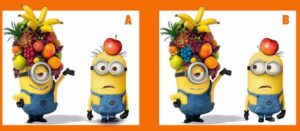
4. Celebrate noticing
Discuss Noticing Others
Set up a display area where students share strategies or ‘top tips’ that they have found particularly helpful in their own learning. For those offering the ‘top-tip’ this is a distilling activity; the resulting gallery of ‘top tips’ invites students to notice (and adopt) the successful strategies of others.
[/dropshadowbox]
Teaching ideas to move learners from Grey to Purple ⬇️
What you are trying to help your students achieve
In the Receives (purple) phase, students need help to notice attentively. They readily see the familiar or obvious but need help to go further. They can describe what they have seen but this too lacks detail. Students know that being distracted isn’t helpful to noticing attentively and do try to ignore common distractions.
Your role as a teacher in this phase is to:
Make students aware of noticing… by formally introducing the idea of Noticing
Talk about noticing…by asking students describe what they see/hear/smell/feel
Give students opportunities to practise it…by helping students to better focus their noticing
Celebrate noticing… by reflecting on, praising or displaying its use
1. Make students aware of noticing… by formally introducing it
Find shapes
Offer students a random set of dots (or picture of the night sky). Invite them to seek items such as:
- A letter of the alphabet
- An animal
- A regular shape
- A face
- Or something linked to the content of the forthcoming lesson
Introduce games that require noticing behaviours
For example… use the familiar Kim’s game where students have to look carefully for a given time and then try to remember the group of articles. This simple format has numerous variations…what’s missing, what’s been added, what’s the odd one out?
2. Talk about noticing
Collect words that tell you how people learn to notice detail.
Relate noticing to well-known sayings
What do we mean when we say …
Eagle-eyed.
I’ve gone through it with a fine-tooth comb.
Keep your eyes peeled
3. Give students opportunities to practise noticing
Notice what’s not quite right
Use intriguing images
For example have an intriguing picture ready on the whiteboard before the lesson starts. Students look forward to looking carefully at pictures where all is not as it seems.
4. Celebrate noticing
Use noticing daily to establish it
Make a noticing wheel; a circle of card, divided into five segments each with a picture of one of the five senses. Add a cardboard arrow. Get into the habit of using it before any activity and ask the students which of their senses they think they might use most in the session and point the arrow to it. You could also point the arrow to the ‘sense’ that you want the students to exercise for each activity or even use it to reflect on which one they did use.

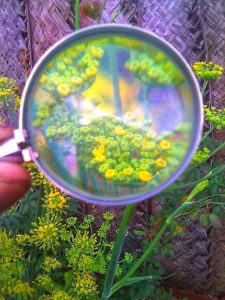




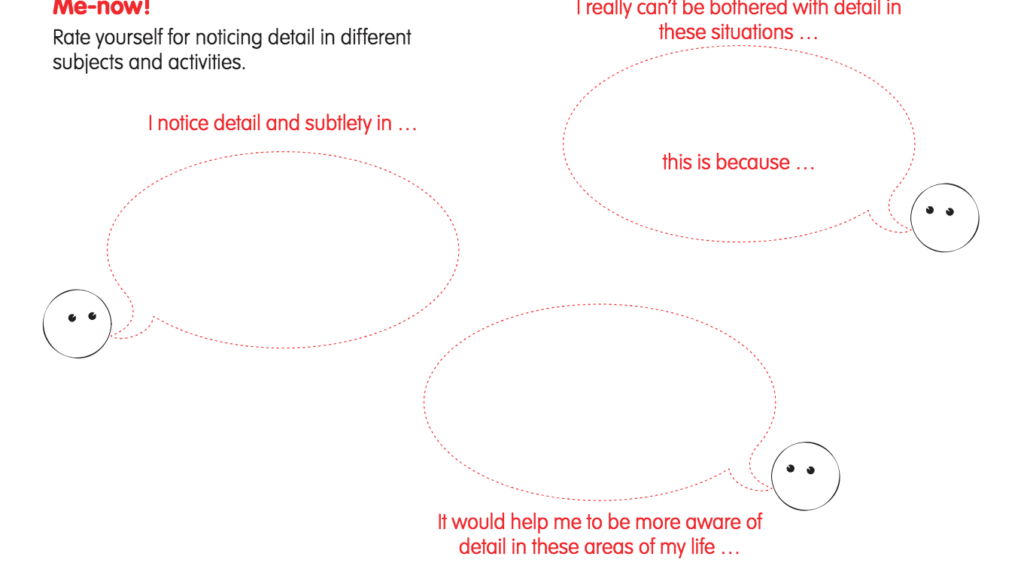

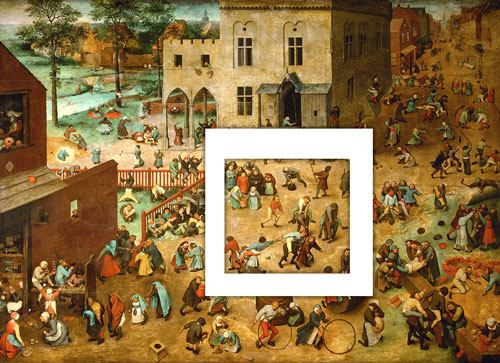




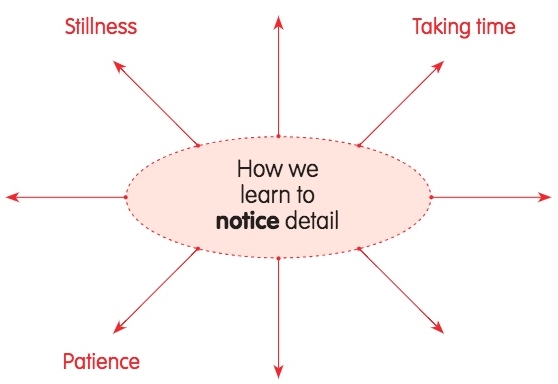

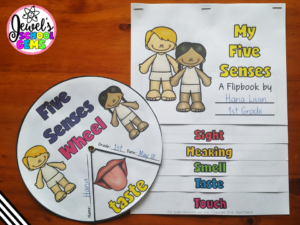

Comments are closed.